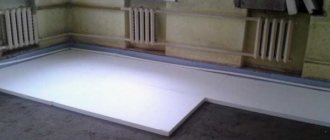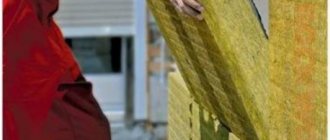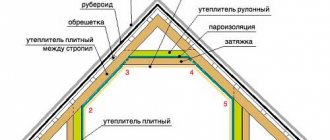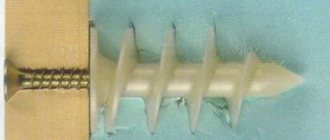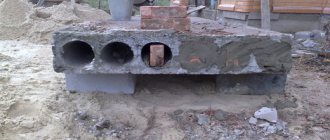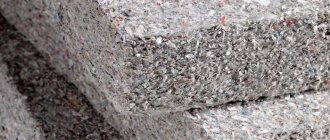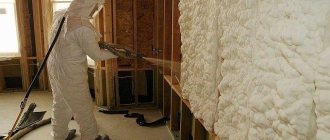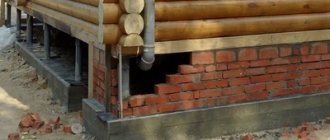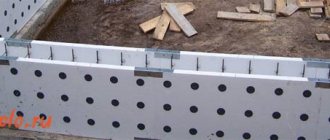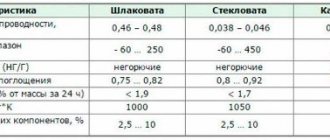Technical features of thermal insulation with polyurethane foam
In order for insulation work using polyurethane foam to be successful, it is necessary to first dig up the foundation from all sides right down to the base so that the width of the trench reaches 0.7-1.0 meters. Otherwise, this may negatively affect the cost of the work performed.
Next, you need to clean off the soil from the surface of the foundation and wait until the foundation is completely dry, since polyurethane foam does not work well with the surface if it is wet. You should also take care of the availability of a 220V DC source; if it is not available at the site, you will need a generator with a capacity of about 5 kW.
It is worth filling the soil back no earlier than three days after the completion of thermal insulation work.
When covering the foundation area above ground level, it will be necessary to make a facing sheathing before starting work so that the margin for the installation depth of the profiles is 0.2 dm in relation to the length of the insulation.
Remember that, like any external construction work, insulation with polyurethane foam largely depends on environmental conditions; therefore, it is not recommended to postpone the bulk of work until the end of autumn (the temperature threshold for this insulation is +5 C°).
Characteristics
There is also no clarity about the characteristics of the material.
Thermal conductivity
When advertising their products, sellers indicate very low thermal conductivity values of polyurethane foam. Rarely, you can find a coefficient of 0.017 W/(m×°K), more often - 0.020-0.022 W/(m×°K). But this is from the realm of fantasy. Even in laboratory conditions, where all requirements for the quality of components and their formulation can be met, it is rarely possible to obtain a thermal conductivity index of 0.022 W/(m×°K).
Similar values are achieved only with the use of freon r141b as a foaming agent, which is prohibited for use in Europe (and therefore is not produced). The use of other foaming agents increases the value of the coefficient, and therefore in European countries a thermal insulation layer with a thermal conductivity of 0.028 W/(m×°K) is considered high quality.
In Russia, the real figures are 0.030-0.035 W/(m×°K) (the specific value depends on the experience of the performers).
However, consumers should not be upset. Even if the technology is violated, the actual thermal conductivity of the insulation deserves respect, since it is one of the best and comparable to basalt wool.
Density
The density of the insulation determines the bending strength (fragility), the weight load on the structure and the thermal insulation properties.
Two-component, closed-cell polyurethane foam, can be obtained in different densities, combined into 3 groups.
- 1 group. Low density - 28-32 kg/m3. The main scope of application is ceilings and walls from inside the room, onto which the material is applied in a thin layer. Thermal conductivity coefficient is from 0.028 to 0.032 W/(m×°K). Vapor permeability at the wood level is 0.05 mg/(m*h*Pa), which makes it possible, albeit conditionally, after detailed calculations, to use polyurethane foam for insulating the walls of wooden houses (more on the problem below).
- 2nd group. Average density - 32-40 kg/m3. A classic representative of the species. The components are sold separately, in cylinders. Used to insulate all structural elements of a building. It has the lowest percentage of moisture absorption among all types of insulation.
- 3rd group. High density - 40-80 kg/m3. Achieving such density using portable equipment is theoretically possible, but practically impossible. It is used in places with high mechanical load on the heat-insulating layer, but only after special surface treatment, which experts call armoring.
Life time
Manufacturers of polyurethane foam consider their products to be durable, with a service life of 30-50 years. These figures are confirmed by the experience of using this insulation in the USA and Europe. However, in Russia, in the first years of using the new product, they were faced with the fact that the insulation from the facades of multi-storey buildings began to fall off in layers after 5-6 years of operation.
At first, the root of the evil was seen in the poor adhesion of polyurethane foam to the wall material. When the lag became widespread, they began to study the problem seriously and turned to Western experience. It turned out that the reason is in a completely different plane - the sun's rays. The material does not tolerate ultraviolet irradiation, ages, or in the language of scientists: it is subject to UV destruction. The aging rate is about 1 mm per year.
The worst enemy of polyurethane foam is the sun.
Simply painting the insulating layer with fade-resistant paint or mastic protects the material from destruction, extending its service life to 30 years when the facade is open. If the insulated facade is finished with siding or porcelain stoneware, you don’t have to worry about the safety of the insulation at all.
Adhesion
Foamed polyurethane has excellent adhesion to all types of building materials, with the exception of polyethylene film. For example, in order to tear polymerized insulation from concrete, you will have to apply a force of at least 2.5 kg/cm2, and for steel - 1.5 kg/m2. These are very large numbers. No wonder the best types of glue are polyurethane based. But such adhesion is possible only if the insulation is sprayed onto a clean and dry surface.
The insulation will not adhere to whitewash and “boiling” plaster; it will fall off along with them under minor mechanical loads due to low bending strength.
PRICE LIST for thermal insulation services
| The cost of insulation with polyurethane foam (PPU) depending on the area with a thickness of 50 mm. | ||||
| Type of work | The cost of insulation when ordering an area | |||
| Up to 200 m2 | 200-400 m2 | 400 -1000 m2 | >1000m2 | |
| Spraying polyurethane foam with an average density of 30 kg/m3 | 700r/m2 | 650r/m2 | 600r/m2 | Negotiable |
| Spraying polyurethane foam with an average density of 40 kg/m3 | 800r/m2 | 750r/m2 | 650r/m2 | Negotiable |
| Spraying polyurethane foam with an average density of 45 kg/m3 | 1000r/m2 | 920r/m2 | 870r/m2 | Negotiable |
| Special conditions for construction companies and architectural bureaus! | ||||
| The cost of insulation with polyurethane foam (PPU) depending on the volume in m3. | ||||
| Type of work | The cost of insulation when ordering an area | |||
| Up to 5 m3 | 5-10 m3 | 10-20 m3 | >20 m3 | |
| Spraying polyurethane foam with an average density of 8-12 kg/m3 | 6000r/m3 | 5500r/m3 | 5000r/m3 | Negotiable |
| Spraying polyurethane foam with an average density of 25 kg/m3 | 11000r/m3 | 10500r/m3 | 9500r/m3 | Negotiable |
| Spraying polyurethane foam with an average density of 35 kg/m3 | 14000r/m3 | 13500r/m3 | 13000r/m3 | Negotiable |
| Spraying polyurethane foam with an average density of 45 kg/m3 | 18000r/m3 | 17500r/m3 | 16000r/m3 | Negotiable |
| Special conditions for construction companies and architectural bureaus! | ||||
The price may change depending on the difficulty of accessing the surface.
Minimum order 30,000 rubles.
engaged in insulation of foundations in the Moscow region. Polyurethane foam is used as a thermal insulation material. This is a polymer that is 98% air. This structure makes it possible to achieve an extremely low thermal conductivity coefficient - from 0.019 to 0.028 W/m*K (almost 2 times lower than that of foam plastic), as well as light weight of the material.
Manufacturers and prices
Experts call the following companies the best producers of polyurethane foam:
BASF Polyurethanes GmbH. The German company is a leader in the production of polyurethanes. The product line also includes polyurethane foam. In Russia, together with OJSC Nizhnekamskneftekhim, they created the Elastokam enterprise to produce components for polyurethane foam.
Yantai Wanhua Polyurethanes Co., Ltd. Chinese manufacturer with a high-quality line of polyurethane foams.
SYNTHESIA INTERNACIONAL SLU The Spanish chemical company SYNTHESIA INTERNACIONAL SLU has been producing polyurethane foam since 2008. The products have found their buyers in many countries around the world, including Russia.
The price from all manufacturers is about $650 per 1 m3.
Application technology
The most common method of polyurethane foam insulation is spraying onto the structural elements of the building.
PPU is sprayed onto the walls.
But there is another way - pouring, which requires a space closed on all sides. It is mainly used in factories producing sandwich panels.
Filling with polyurethane foam.
On the floor
Before spraying insulation on the base of the floor, preparatory work is carried out, including: removing the old screed, repairing the concrete base (in a wooden house the subfloor is being restored), waterproofing the ceiling or subfloor. The preparatory process is described in more detail in the material “Preparing the floor for pouring screed.”
A lathing for laminate, parquet, linoleum or joists for floorboards is mounted on the prepared surface. At the same time, both the sheathing slats and the joists should be 20-30 mm higher than the insulation. The gap is necessary to ensure ventilation.
On the walls
The technology for insulating the facade and walls from inside the room is the same. Consists of sequential operations:
- the old finish is removed from the surface of the walls (you can see how to quickly remove it in the work “Aligning walls for painting”);
- the sheathing is installed;
- polyurethane foam is sprayed. In this case, special attention must be paid to corners, crevices and voids;
- areas with protruding insulation are trimmed with a knife (easy to detect as a rule);
- Drywall is attached to the sheathing for finishing with wallpaper, painting or decorative plaster.
To the ceiling
Insulation of the PPU ceiling is carried out under a suspended or suspended ceiling. In this case, the old finish is removed from the surface of the floor slab, after which foam is applied in a thin layer (lathing is not required).
How to insulate a foundation from the outside using polyurethane foam
If you are going to use polyurethane foam as thermal insulation, then you should follow the following procedure:
- Dig a trench around the building to the very base of the foundation, at least 70 cm wide.
- Clean the foundation from the soil and dry it to improve the durability of the sprayed material.
- Make sure that the mains voltage is 220 W.
- Apply the polyurethane foam itself using a special sprayer.
- Allow the coating to dry for three days, then fill the trench back.
- Remember that maintaining the temperature regime is very important for this kind of material - it is better to carry out work in spring or summer, when the temperature is above +5°C.
Polyurethane foam is a difficult material to work with, but it is of very high quality and durable, so if you are not confident in your abilities, it would be better to hire a team of professionals.
No less well-known is the method of insulating the outer part of the foundation with polystyrene foam and polystyrene foam.
Insulation of PPU foundation
Polyurethane foam is suitable for insulation both inside and outside the room, but it is preferable to use it for external thermal insulation of the foundation. In case of significant unevenness, the foundation is leveled using cement-based masonry mortar. Although polyurethane foam has good waterproofing properties, the foundation is additionally waterproofed with bitumen mastic in 2 layers.
How to properly insulate a foundation with polyurethane foam? If it is necessary to create a layer of thermal insulation about 5 cm thick, the material is sprayed in one layer. If a large thickness of insulation is required - 2 or more layers. The mixture is sequentially applied over the entire working area, moving from top to bottom. Note: in order for the insulation of the underground part of the foundation of the building with your own hands to be successful, you should, in addition to it, cover at least 0.4 m of the above-ground part with insulation.
This precaution will prevent the possibility of melt water from entering an unprotected area of the building in early spring. After the polyurethane foam has completely hardened, the trench is backfilled, as well as a blind area is installed, which helps to increase the operational life of the insulation.
We insulate the PPU foundation
When the preparatory work is completed, you can begin to insulate the foundation. To do this, you need to use a special tool called a “spray gun”
In addition to this you will need:
Respirator.- Work or old clothes.
- Polyurethane foam.
- Protective glasses.
Due to the fact that the material itself is caustic, ordinary clothing cannot be used. In addition, it can be harmful if it gets into the eyes or respiratory tract.
After this, you should connect the cylinders to the sprayer and you can start. It is necessary to spray the insulation evenly from top to bottom, and at the same time go around the perimeter. In one approach, you cannot apply more than 4 cm of insulation in thickness. If greater thickness is required, do this in several approaches.
I would like to note that polyurethane foam can be sprayed onto small areas of the ground foundation, but their size should not be less than 0.5 meters. This is necessary to prevent wastewater from flowing behind the insulation layers, which can lead to rapid destruction of the insulation and create a pocket between the foundation and the building.
The process itself is simple and does not require special skills. It is only important to have good equipment that can evenly distribute the insulation over the surface. Polyurethane foam does not harden for a long time, usually a few minutes are enough, after which a new layer can be applied. But you cannot immediately fill the trench, since the material must “settle.”
When the polyurethane foam coating hardens, you can cover it on top with a layer of bitumen. This will improve the quality of the component and extend its service life. After this, you can dig a trench.
Interestingly, to protect this insulation from water, it is recommended to make a blind area, which is important for those areas where winters are very cold.
Next, finish the top part of the insulation along the frame. There are no requirements for operation, it is only important to protect the polyurethane foam from sewage and rain.
PU foam application technology
The material is applied to the working plane with a gun in such a way that the average thickness of the layer in one pass fluctuates between 0.5-1.0 cm. In this situation, the consumption of polyurethane foam, which varies depending on weather conditions, the topography of working areas, etc., will be 0.5-1.0 kilograms per square meter.[nggallery id=165]
To ensure that the final result of the work does not disappoint its performers, it is recommended to use special devices - low and high pressure units, which include units of the “Foam” type, as well as their modifications, the basis of which is the principle of dosing using gear pumps. Note that mechanisms with plunger pumps are most widespread. The technological process of thermal insulation with polyurethane foam consists of the following sequential stages:
- Inspection of equipment;
- Preparation of working surfaces;
- Preparatory work regarding building materials;
- Control spray to determine the quality of polyurethane foam;
- Spraying itself.
For acceptable adhesion of polyurethane foam to the working surface, it must be damp, free of dirt, oil, traces of paint, rust, etc. An important aspect in the context of reliable preservation of foam is ensuring proper storage conditions for the containers in which it is located. Because The components that make up this building material are subject to slight delamination over time.
For this reason, you will have to homogenize the contents of PU foam barrels by rolling them. In addition, the foam in containers should be thoroughly mixed before starting work and after a period of time. To avoid unsatisfactory quality of work, we advise you to adhere to the technological proportions of the components specified in the data sheet of the PPU system.
The insulated surface is covered with polyurethane foam in layers, which leads to the achievement of high adhesion in the joint areas. The most effective insulation results can be achieved by following the instructions below:
- Surfaces must be dried and dry;
- Wind speed should not exceed 5 km/h;
- Lack of precipitation;
- During external work, weather conditions must correspond to the norm (temperature of the outside of the foundation is above +10°C; temperature of components is within 18-25°C;
- The thickness of the once sprayed layer is no more than 1.0 dm.
Polyurethane foam application technology
The sprayed composition is two-component. Polyols and isocyanurates are supplied in separate containers. Most installations for applying polyurethane foam have the following operating configuration:
- Blower compressor. Creates excess pressure in working tanks.
- Working containers. Depending on the component supplier. Usually these are standard steel barrels of 150 - 200 liters.
- Mixture preparation apparatus. It consists of two pumps and a central control panel, where the components are mixed and (if necessary) heated to the required temperature.
- Application gun and flexible hose kit.
Equipment for applying polyurethane foam
In addition, plant operators must wear protective suits, goggles and respirators. During the polymerization process, gaseous substances hazardous to health are released.
The physical properties of the insulating layer depend on many factors: the proportions of mixing the components, the temperature of the mixture, the pressure of the mixture at the outlet, the temperature and humidity of the environment, the thermal conductivity of the insulated surface. Thus, obtaining insulation with comparable characteristics requires prompt adjustment of parameters when applying the mixture from concrete to metal or when the weather changes.
The surface of the foundation is cleaned of dirt and paint. Loose fragments are removed. Depending on the qualifications of the craftsmen and the technology used, drying may be required.
A number of experts consider it necessary to apply waterproofing bitumen mastic before work. However, this is not urgently necessary: the foam itself has waterproofing properties. In some cases, with significant porosity of the base, it makes sense to pre-prime in order to reduce the consumption of polymers.
The mixture is applied in liquid form to the surface in a continuous layer, or the cells of the existing sheathing are filled. The composition expands approximately 100 times upon polymerization. Therefore, to obtain a layer close in thickness to the required one, some experience is required.
A polyurethane foam thickness of 3 - 5 cm is considered the minimum basic thickness. If more significant insulation is required, a second layer is applied.
When working with polyurethane foam, you must wear a protective suit
If you called a team to thermally insulate the foundation with sprayed polyurethane foam, you should prepare the working conditions:
- The trench exposing the surface must be at least 70 cm wide.
- The surface must be cleaned and dried.
- The electricity supply must provide at least 5 kW of power.
- Have material to cover the resulting surface from exposure to uv radiation.
Independent use of the described technology does not make much sense for many reasons. Firstly, you need to have a set of expensive equipment. Rent, accordingly, will also not be cheap. Secondly, it requires professional skills that are not acquired through a few square meters of trial application. Thirdly, the basic amount of polymer contained in two barrels is about 300 kg, and for insulating a shallow strip foundation of a house with an area of about 100 square meters. m. takes, on average, no more than 40 - 50 kg. There are compact kits for repair insulation, but the cost of the material in them is much higher, and the quality of the resulting insulation leaves much to be desired.
Step-by-step instructions for insulating a polyurethane foam foundation using the example of using POLYNOR® sprayed polyurethane insulation
Still, it is possible to apply polyurethane foam yourself. One option is the Polynor composition. Here are photo instructions for insulating a foundation wall with NPU POLYNOR
. The work is not difficult and is suitable for do-it-yourself insulation. Only one person is involved in the insulation process. In this example, the insulation area is 34 m2, the thickness of the two-layer thermal insulation is 120 mm, the process took 2 hours.
The foundation surface is prepared for applying thermal insulation
Apply Polynor composition to the surface of the foundation
Cans with sprayed insulation
You need to work using protective equipment
Polynor application is nearing completion
Close-up of polyurethane foam insulation
Difficulties when working with PPU
The most characteristic deviations from the normal course of spraying polyurethane foam insulation are the flow of foam from vertical, inclined or ceiling planes, technological shrinkage, the occurrence of local cracks or structural heterogeneity of the foam.
The above problems are a consequence of equipment malfunctions, neglect of standard dosages of components, and adverse weather conditions.
Thus, PU foam cracks manifest themselves at subzero temperatures. In addition, such insulation, after final hardening, is more susceptible to deterioration in strength characteristics due to bending or due to adverse weather factors. Microcracks that will not subsequently increase in volume are allowed, while through cracks - potential places for accumulation of water, and in winter - snow - must be promptly eliminated.
Pros and cons of PU foam spraying technology
Insulating the foundation with polyurethane foam has many advantages. The thermal conductivity coefficient is only 0.025 W/m•K. Elimination of additional loads on the area undergoing insulation, as well as the absence of the need to strengthen the load-bearing structures in the case of using low-density rigid polyurethane foam (0.35-0.70 centners per cubic meter).
Continuous adhesion of interacting surfaces ensures their protection from condensation. Excellent resistance to aggressive environments and compounds of various chemical elements. The structure is practically non-porous, increasing the moisture-repellent properties of the insulation. The mobility of the equipment makes it possible to work both on regular construction sites and on individual objects.
The productivity of modern equipment is such that in a working day two specialists are able to insulate 500-1000 square meters of treated area.
Flammability
Polyurethane foam is a self-extinguishing and fireproof . Its flame resistance increases in proportion to the density; accordingly, the safer it is to insulate the room, the denser the polyurethane foam you need to choose. This feature of the material allows it to be used for insulation of children's and preschool institutions.
Insulation with polyurethane foam - pros and cons
Polyurethane foam has low thermal conductivity, which is (0.029-0.041) W/ (m • K)2. A 4 cm thick layer of foam protects against the penetration of cold as well as:
- 18 cm foam;
- 60 cm of aerated concrete;
- 170 cm of brick;
- more than 150 cm of concrete.
This comparison reflects the benefits of applying polyurethane foam much more effectively.
Another advantage of the material is its
high adhesion .
This property allows it to stick and hold securely on almost any surface. Boards, concrete, rubber, brick, slag casting - polyurethane foam is securely held on all of this. Cured insulation can only be removed mechanically, this is explained by its resistance to all organic solvents , which allows the use of polyurethane foam even in places where oil, gasoline and other aggressive substances can get on it.
If the polyurethane foam insulation is not damaged mechanically and is protected from direct sunlight, then its service life will be at least 25-30 years, respectively, during this entire period the owner of a house whose foundation is insulated with polyurethane foam should not worry worry about the quality of the insulation.
The low weight of the insulation allows its load not to be taken into account when designing a building, but at the same time, its surface in a frozen state is quite dense.
The hygroscopicity of the material is low, due to this property, the material can be used without additional waterproofing.
Thanks to the seamless application method, there are no cold bridges . This phenomenon can be observed when installing sheets of polyurethane foam and it means that at the junction of the sheets, freezing of the base occurs, which adversely affects the foundation. Another advantage of polyurethane foam is the ability to apply it to any geometric shape.
Flammability
Polyurethane foam is a self-extinguishing and fireproof . Its flame resistance increases in proportion to the density; accordingly, the safer it is to insulate the room, the denser the polyurethane foam you need to choose. This feature of the material allows it to be used for insulation of children's and preschool institutions.
Minuses
The disadvantage of polyurethane foam thermal insulation is considered to be its poor resistance to direct sunlight , which means that after installation and polymerization the insulation must be covered with finishing materials that will protect it from exposure to the sun.
This is interesting: the well-known foam rubber also belongs to the group of polyurethanes, only it has a soft cellular structure, and as you know, it is an excellent insulation material, used almost everywhere.
Polyurethane foam and other thermal insulators - comparison
In terms of thermal conductivity, polyurethane foam can be second only to aerogels. But so far the scope of aerogels is limited only to scientific and exotic high-tech. The closest competitor, namely extruded polystyrene foam, is 19-20% worse.
As for the other properties of polyurethane foam, which are important in construction practice:
- In terms of compressive strength, the indicator ranges from 120 to 155 kPa. Inferior to extruded polystyrene foam, corresponds to medium density brands.
- Moisture permeability less than 1%! Although FPP accumulates more moisture than EPS, it is still less than other thermal insulators.
- Interness (chemical). The material is resistant to any alkali and acid at low and medium concentrations.
- Degree of adhesion . Thanks to the special coating, the grip is excellent. It is especially important that this does not depend on the shape, type of surface material and degree of roughness.
- Fire safety level . Depending on the amount of fire retardants added, this ranges from G1 to G4. But such additives reduce the energy efficiency and insulation of polyurethane foam foundations.
- Price . The cost of spraying a coating 5 cm thick in the regional center will cost from 11 to 14 dollars per 1 m2, depending on what density you want to obtain. This is much more expensive than EPS boards and polystyrene foam. But you need to compare economic efficiency taking into account the full cost.
- Radiation protection . The insulation cannot be exposed to the sun without shelter for more than 4 days.
When is it better to use PPU
Insulating material can be installed inside or outside the structure, but external insulation of the base is preferable - the risk of condensation on the walls is significantly reduced. Protected concrete degrades less frequently and takes longer.
Applying polyurethane foam to the sheathing
Sometimes they use materials with multi-layer application, which is not always appropriate, but not very effective.
You need to be prepared that the amount of expenses for external work will be higher than for internal work.
Complex base design
It is inconvenient to use slab material for thermal insulation; voids form between the two surfaces, through which moisture and cold will penetrate.
Height differences immediately arise, which will become a significant obstacle to further cladding of the building. The issue can be resolved by installing complex sheathing, which complicates the work even more and increases the already high costs.
Insulation of a house of complex shape using polyurethane foam
Liquid polyurethane foam solves these problems and allows you to apply an even layer to any structure.
To spray the material, use a construction sprayer. At first, the substance will form a thin white layer, but will quickly begin to significantly increase in size. The result is a dense monolithic coating that fills the pores and is maximally fixed on the working surface.
Large surface processing
Liquefied polyurethane foam allows you to process large areas, relevant for buildings with an area of more than 100 square meters. meters. It is almost impossible to guarantee the tightness of joints, but monolithic protection assumes their complete absence.
If there are no seams or joints, there is no need to buy sealing materials, waste time on processing, or wait for complete drying to double-check the result.
Polyurethane foam is more expensive, but costs for associated manipulations are eliminated. Average savings reach 10-15% of the total cost.
Little time to install thermal insulation
It is impossible to guarantee consistently good weather; working in conditions of heat, cold, and precipitation reduces the technological characteristics of the material.
A lot of time is spent on the direct installation of insulation; you will need to wait a drying period to obtain high-quality thermal insulation.
PU foam polymerizes quickly
The advantage of polyurethane foam for spraying is that two people can process up to 500 square meters in one day. meters.
The process of complete polymerization of the sprayed substance, taking into account the ventilation of the premises, takes no more than a few hours. Polyurethane foam is suitable for urgent work.
How important is sound insulation?
In addition to the safety of the structure, saving resources for heating, creating comfortable living conditions, good sound insulation is noted.
The porous material suppresses incoming sound waves, the insulating coating is a damping type shell that absorbs the emitted waves.
Sound insulation at the bottom of the building significantly improves living conditions - sound vibrations pass through the ground and solid materials. Installation of relatively soft, porous protective structures allows you to stop sound before it penetrates the walls of the house and is transmitted inside.
How is PPU foam applied?
Foam raw material is a two-component material, the components of which are mixed before direct use.
Most equipment for spraying polyurethane foam consists of several parts. The compressor builds up pressure inside the equipment. The main containers contain the incoming mixed material.
The elements are mixed and heated inside a mixing apparatus, consisting of a main control panel and a pair of pumps. Spraying occurs through a gun connected to soft solution supply pipes.
Working with special equipment for spraying polyurethane foam
A person working with liquefied polyurethane foam must wear protective clothing that covers the entire body and head. You need plastic goggles, a respirator, rubberized gloves, and thick closed shoes.
Precautionary measures are related to the fact that during the application of raw materials, harmful substances that are dangerous to human health are released into the airspace.
The final properties of the applied insulation depend on the proportions of the components, heating temperature, and pressure during application. Secondary factors influencing the condition of the insulation are air humidity, outside temperature, and how well the main surface transmits heat.
Before work you need to prepare the base. Dirt and dust are removed from the surface of the base, loose areas of the structure are immediately identified and eliminated. Depending on the work and insulation technology, it may be necessary to artificially accelerate drying with a hair dryer.
The liquid substance is sprayed in an even layer over the base, or the assembled sheathing is filled. But it’s better to gain experience, hire specialists, or act under the guidance of a master - the applied coating increases in size up to 100 times. To do it right, you need experience with the material, which beginners don’t have.
The optimal thickness for applying the base layer is 3-5 cm; re-treatment is carried out if thicker thermal insulation is needed.
If specialists have been hired, you need to prepare the work site - dig a trench to the depth of the plinth, 70 cm wide. The outer walls of the structure are cleaned, dried, and a coating is prepared to protect them from the ultraviolet rays of the sun.
The process of insulating a large area inside a prepared ditch
It is impossible to do it yourself - you need equipment and experience in operating the PPU. Both options require investment.
It is difficult for one person to cope with the work; there is a high consumption of material - up to 50 kg of polyurethane foam to cover about 100 square meters. meters of tape fill. Inside the equipment there may be about 300 kg of raw materials prepared for mixing, which must be properly used and disposed of.
There are more compact models of devices with less material content, but this will increase budget waste and the quality of application may deteriorate.
In what cases is polyurethane foam insulation preferable?
If we talk about energy efficiency, polyurethane foams are better than polystyrene, but the low cost of the latter makes it possible to compensate for the properties by increasing the thickness. On the other hand, there are some technological factors that make the use of polyurethane foam advisable.
Unusual foundation relief
There is a main disadvantage of polyurethane foam insulation, namely the formation of voids between the mounting surface and the insulation. There is a high probability that moisture will get into these voids and create unaccounted for cold bridges. In addition, large differences in the plane do not provide a chance to cladding certain surfaces without installing complex sheathing. These objects include stone foundations in old buildings. The issue of insulation is of particular importance if the building is classified as an architectural monument.
Preparation before application
To start insulating with polyurethane foam, you need to perform a number of preparatory work. They will help to significantly increase the efficiency of insulation and extend the service life of the insulation. It is necessary to determine in advance what kind of insulation work will be carried out and where. Remember that insulation is carried out not only in the above-ground part, but also in depth, on average about 1 meter of the underground part and 0.5 meter from above.
After this, a trench must be made around the building to make room for work. It should be 1 meter deep and 0.7 meters wide. The second indicator is individual, since you need to make room for work.
After this you will need:
- Clear the foundation of plants and dirt.
- Restore crumbling parts of the foundation or eliminate them.
- Dry the work surface.
Yes, first you need to get rid of the fungus, dirt and plants that are on the surface of the foundation. After this, check the foundation for cracks, crumbling parts and spalls. Although polyurethane foam can be applied to any surface, reliability and uniformity increase the service life of the material.
After this, dry the foundation thoroughly. To do this, leave it for 3 days, provided the weather is good outside and there is no precipitation. If this requirement is not met, you will have to use special equipment.
Please note that polyurethane foam does not adhere well to a damp surface, which can give a bad result in the form of a thin layer of air between the insulation and the foundation, and this in turn will contribute to the formation of condensation.
At the top of the foundation, which you will insulate, make a frame for the cladding. Since it will not be possible to apply facing materials to polyurethane foam, a metal sheathing will be required, on which the panels will then be installed.
Life hack: since insulation involves digging the soil and drying the foundation, such work is best done in the summer.
Now all significant irregularities will be smooth. Sometimes it makes sense to do a full recovery before you start. This will make it possible to use insulation more efficiently and increase its service life.
After preparation, cover the foundation with a protective compound. This will remove microorganisms, improve adhesion, and increase service life. After this, cover the foundation with bitumen in two layers. Although the insulation itself protects well from moisture, a layer of bitumen will not hurt.
Waterproofing foundations with sprayed polyurea: reliable, fast, profitable
Modern technology for waterproofing foundations of buildings and structures by spraying polyurea allows you to create protective coatings for structures of any type, waterproof monolithic foundation slabs, treat vertical surfaces of plinths/basements, horizontal waterproofing, etc. at a speed unattainable by other technologies:
- there is no need to divide the foundation surface into sectors, install external waterstops and injection tubes; there are enough internal (more reliable) waterstops to seal working and expansion joints;
- coating up to 3.5 mm thick is sprayed in one pass - there is no loss of time for intermediate drying of layers;
- polyurea cures instantly (5-7 seconds) - does not flow off vertical, spherical surfaces;
- the speed of work on waterproofing the foundation with polyurea is up to 500 m2 per shift by one team;
- quick commissioning - in a few seconds you already have reliable protection from water, and you can backfill 10-12 hours after treatment;
- any deficiencies are detected by a simple visual inspection and eliminated locally by spraying an additional layer - easy and quick quality control.
Modern waterproofing of foundations with polyurea: long lasting
Modern waterproofing of foundations with sprayed polyurea combines the advantages of coating, welding, lining materials, liquid rubber and membranes, is free of their disadvantages and has unique performance characteristics:
- a completely seamless coating that adheres to the base every centimeter;
- absolute waterproofness in all conditions;
- high elasticity (up to 600-800%) and high tensile strength (up to 20 MPa) - the ability to compensate for structural movements while maintaining integrity;
- operational durability - sprayed polyurea foundation waterproofing does not become embrittled, does not crack, does not decompose in soils containing aggressive agents;
- high resistance to puncture and impact - no damage when backfilling the foundation;
- durability - service life up to 50 years while maintaining the original parameters.
Is it worth insulating the foundation with polyurethane foam from the inside?
Yes, it's worth it. This must be done at the construction stage, when there is access to the internal parts of the structure. With double-sided insulation, the thermal conductivity of the lower part of the house is significantly improved, and the service life of the foundation is increased.
If there is a basement or cellar under the house, it can also be insulated. In this case, mold and mildew will not appear on the walls, and the room will become much drier and warmer.
But such measures can only be used as a complement to external spraying. If you insulate the foundation only from the inside, leaving the outside open, groundwater and frost will continue to destroy the material. Although the basement will be dry, the foundation may crack, causing the structure to shrink.
Foundation waterproofing: price for a turnkey complex
We calculate a detailed estimate after examining the site and developing technical specifications, and indicate the cost of foundation waterproofing work per m2, taking into account the entire volume of operations:
- materials - polyurea system, primers/primers, detergents, etc. consumables as necessary;
- logistics;
- surface preparation - eliminating imperfections, cleaning, priming;
- spraying PM (and applying polyurethane foam if necessary).
As we have already mentioned, the shortcomings of sprayed polyurea coatings are often associated precisely with errors in the technical specifications, when they forget to take into account one or another important operation and, accordingly, do not include it in the estimate.
In the Begemot Group of Companies, such an approach is impossible: the cost of foundation waterproofing includes the price for each operation that must be performed to obtain a high-quality result. Since all objects are different (operating conditions, surface condition, ease of access, location, etc.), without a survey it is impossible to accurately determine the amount of expected costs, but below we publish the average price for a preliminary assessment.
| foundation waterproofing | price per m2, rub. |
| horizontal under a monolithic slab | from 1500 |
| vertical | from 1700 |
| vertical with PPU insulation | from 2700 |
Often, the cost of waterproofing the foundations of buildings and structures with polyurea is quite comparable to the price of coatings made from traditional materials, even without taking into account the extended service life. But taking into account its durability and reliability, it is cheaper than other coatings. And in conditions of high groundwater, this is the cheapest option among the truly effective ones. Just contact the engineers of Begemot Group of Companies, and specialists will offer an option specifically for your task.
Insulation of the foundation of multi-storey buildings
Polyurethane foam is used to insulate not only private households, but also apartment buildings. This material is sprayed onto any type of foundation of high-rise buildings - slab, pile, strip, combined. Nowadays this is done already at the construction stage. For such work, only high-density closed-cell polyurethane foam is used.
But buildings built many years ago do not have such insulation, so it has to be carried out separately. Insulation is applied to the outside of the house wall and inside the basement. Dried and hardened polyurethane foam is covered with facade plaster or other finishing materials.
Work is carried out at a temperature of at least 5 degrees in dry, windless weather. Since the spraying speed is quite high, in one or two days you can insulate the entire foundation of even a large house.
PPU-polyurethane foam.
What is the best insulation?
Ask this question to any construction specialist and you will get the answer - none. Each insulation has its own “specialization” and is most effective for its range of tasks. Mineral wool and ecowool are popular when arranging roofs and facades, polystyrene foam is suitable for budget insulation of walls, for example, administrative buildings, polystyrene is effective as insulation for floor screed. In the same article we will talk about the advantages and applications of sprayed polyurethane foam (hereinafter referred to as SPP). Polyurethane foam is applied to surfaces of any geometry, forming a seamless monolithic coating (as a result, it is warmer in winter and cooler in summer). Unlike mineral wool and ecowool, it does not emit dust, does not become saturated with water, does not settle and does not crack.
Polyurethane foam is a polymer compound that is absolutely neutral and does not react with any substances. You may have come across it in construction hypermarkets under a brand, for example, Polynor, which is sold in cans costing 450-500 rubles. Using polyurethane foam, any homeowner can insulate small areas, such as garage doors or a balcony. To insulate surfaces of a larger area, purchasing and spraying with a spray can is no longer practical: it is more profitable to order installation with special equipment for spraying polyurethane foam. In addition, polyurethane foam is a collective concept; polyurethane foam in cans in construction markets and polyurethane foam in barrels have different compositions, with different properties.
The general director of SoyuzEnergiaService LLC (Kazan), a company that applies polyurethane foam and eliminates poor-quality thermal insulation, Vladislav Shubin, will tell you more about the properties of the material.
When spraying polyurethane foam using a special gun, the components are mixed. Under pressure, in the form of very fine dust, the components are mixed in a gun and sprayed onto the surface, where they foam and then harden. Just 15 seconds! When pouring into cavities and molds, the polymerization time is increased so that the emulsion has time to be evenly distributed inside the wall. This is what insulation with polyurethane foam consists of.
How to insulate polyurethane foam in a multi-storey building
First, the building is dug to a depth of 50-60 cm. The walls are cleared of soil and dried. Sand is poured into the bottom of the resulting trench. After this, polyurethane foam is sprayed onto the entire surface of the foundation, covering approximately half a meter above ground level. The dried foam is cut off and plastered. You can use special finishing boards instead of plaster. The polymer that is above ground level is finished with cladding.
A concrete blind area with drainage channels, ebbs and drains is organized around the house. After such work, the basement of the house becomes dry and warm, and heating costs are reduced by 15%. In addition, cracks stop appearing on the foundation and facade of the house, and basements are not flooded by melt water.
Having insulated the foundation, you don’t have to worry about its durability and strength, especially if you have chosen reliable and durable waterproof polyurethane foam as insulation. Since this material is not cheap, to carry out the work you need to contact companies that cooperate directly with manufacturers of polyurethane foam components. Such companies offer fairly reasonable prices, have modern equipment and employ experienced specialists.
More information about the material
Now let’s figure out how to insulate the foundation of a house from the outside, what exactly is so good about polyurethane foam, and why it is optimally suited for treating the foundation. Here is a list of material characteristics:
- thermal conductivity coefficient: 0.025 W/mK (for comparison, for mineral wool this figure is 0.05-0.06);
- density: about 60 kg/m³;
- weight: about 1.7-1.8 kg in 1 “square” 3 cm thick;
- operating temperature range: from -100 to +100 degrees (for some brands it expands in both directions);
- durability: under normal operating conditions it can reach 40-50 years without significant loss of quality characteristics.
Now let's list the properties of polyurethane foam:
- absolute resistance to moisture - the material does not deteriorate even with constant direct contact (which is primarily important when treating the foundation walls of a house);
- neutrality in biological terms - fungus and mold do not appear on the material;
- significant soundproofing properties;
- fire resistance - the extruded material is difficult to burn even in its usual version, and the use of special additives makes it resistant to direct fire (on contact, a layer of coke is formed that prevents the spread of flame);
- reliability of the layer - over time, the applied polyurethane foam does not crumble or crack.
The first point is not just a marketing phrase from manufacturers. PU foam really tolerates long-term direct contact with moisture without any problems. Proof of this is, for example, the fact that the material is actively used in shipbuilding. This factor is extremely important when insulating the foundation walls of a house - since this part of the structure is almost always exposed to moisture, the blind area only slightly removes moisture. And due to the material’s resistance to liquids, additional waterproofing is, in fact, not necessary.
Stages of material application
We will consider both technologies, but we will pay more attention to sputtering.
First, let's list the general stages of work:
- The blind area is removed around the walls and a trench is dug with your own hands to the full depth of the foundation. Its width should be sufficient for comfortable work inside.
- The surface of the walls is cleaned of dirt, dust and remaining materials (if any) using metal and ordinary brushes.
- The integrity of the structure is checked.
- If there are cracks, plaster is used to seal them.
- The surface of the walls is primed (additional waterproofing will not be superfluous, despite all the advantages of the material).
Spray equipment
The two-component high pressure unit is a tool for applying polyurea. It works on the principle of a pump. Components are supplied from two containers, which are heated to 60-80 degrees Celsius for half an hour, then mixed and supplied to the spray hose. This in turn is connected to an industrial pistol. There is no air inside the installation, so the polyurea comes to the surface with an airless torch and at this moment both components are mixed. Polymerization occurs very quickly. Within a few minutes, the material hardens and the consistency resembles something between hard rubber and plastic.
The most popular high pressure units are Graco and Gama. The weight of such sprayers varies from 100 to 300 kilograms, depending on the type. Graco units combine an electric dispenser and a diesel generator to reduce electricity consumption. Using the device control system, you can control work anywhere, as well as view the activity log.
When purchasing or working with any high pressure unit, it is important to think about the length of the hose. They can be different: from several tens to 120 meters. When it comes to large rooms and volumes of work, it is worth choosing a longer hose.
Sputtering process
As was said earlier, polyurethane foam has good adhesion and the quality of the base is not important for it, so the entire process of preparing the foundation for spraying foam comes down to the fact that it needs to be cleaned .
If desired, it is possible to use polyurethane foam in conjunction with additional waterproofing. In this case, it is installed in advance and after complete drying, the foam is applied directly to it.
Before applying foam , if in the future the foundation is planned to be sheathed using a frame made of metal profiles, it is necessary to mount the hangers and install them in their working position, that is, bend them.
The hangers will not interfere with the spraying, but such preparation will significantly save the time that will be required to install the frame; moreover, the hangers installed in advance will hold on even more reliably in the future, after spraying the insulation. If it is planned to insulate the foundation with polyurethane foam in a block base, then for greater efficiency of the insulation, all joints of the blocks must first be cleaned of dust and poorly adhering fragments of concrete. Such actions will ensure maximum penetration of insulation into the cracks between the blocks, which in turn will have a positive effect on the thermal characteristics of the building.
Organization of a plinth on a pile foundation
If you plan to insulate a pile-screw foundation, then to apply insulation, you need to make a wooden frame . It can be made by connecting all the piles together using wooden blocks, and for this purpose welding guide corners onto the piles.
Depending on the height of the pile foundation, the number of parallel installed bars can vary from two or more. After the guides are installed, the gap between the ground and the first casing must be sewn up with wood. Thus, you will get a reliable frame, onto which polyurethane foam is subsequently applied. Insulation can be applied to a wooden frame both on the outside of the false base and on the inside; this will only increase the strength of the structure and improve the thermal insulation performance. If desired, the structure of such a plinth can be buried slightly into the ground. When insulating the walls from the outside with polyurethane foam, it is imperative to finish such a base with finishing materials.
Important: when choosing to insulate the base in a pile foundation using foam, it is advisable to prepare the frame so that the piles fit inside the structure. In this case, after applying the foam, they will be inside it, which will make the structure of the pile foundation even more reliable, since polyurethane foam has anti-corrosion properties.
Spray installation
Unlike conventional polyurethane foam, which is used when installing windows, polyurethane foam is applied using special equipment. The principle of its operation is that, under air pressure, two components are supplied through special hoses to a gun, at the outlet of which, thanks to high pressure and turbulence, they are mixed and fall onto the insulated surface, where final polymerization takes place.
Such installations are quite expensive and for this reason, when constructing yourself, it is better to use the services of a company specializing in spraying polyurethane foam. The company’s specialists will be able to evaluate the thermal characteristics of the building and advise on the required coating thickness. It should be taken into account that the cost of spraying polyurethane foam depends on the consumption of the material, and this, in turn, on the thickness of the applied insulation.
How much will it cost to order a team to insulate the foundation of a substation?
If you listened to our advice and decided that thermal insulation of the foundation is still the work of a master, then you are probably wondering how much you will have to pay for this service. The total price for insulating a polyurethane foam foundation will depend on the quality of the material itself, the thickness of the required layer, as well as the size of the base that needs to be insulated. In addition, the region in which the work will be carried out also plays a fairly important role. Thus, ordering a team to carry out thermal insulation of the foundation can cost from 143 to 570 hryvnia per cubic meter.
It is optimal to choose the middle price category. It is worth carrying out thermal insulation with materials that have the highest thermal conductivity coefficient, are not afraid of dampness and moisture, and are also resistant to the influence of an aggressive external environment. This is exactly what rigid polyurethane foam is.
